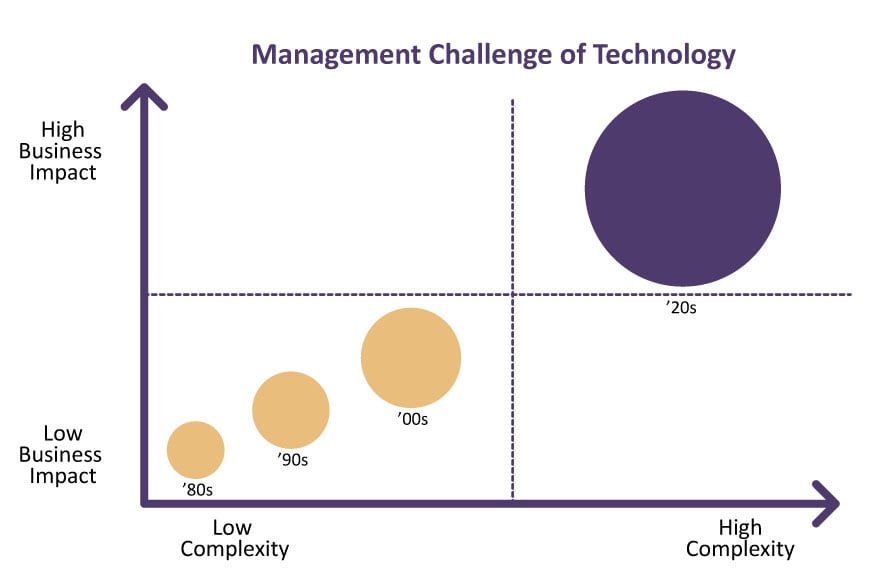
Largely due to Covid-19, a lot of small and medium size businesses (SMBs) have achieved a decent technology maturity over the last couple of years. Their networks are fast, they’ve moved to the cloud, most of their core processes are digital and they can work now remotely.
However, most still struggle to turn technology opportunities into measurable business improvements. They’ve adopted Microsoft Teams of Google Platform to work remotely but struggle to get things done on time. They’ve implemented a modern CRM solution to improve sales, but the team still isn’t using the critical functions properly and thus don’t get the desired results. Despite their accounting system being fully functional, executives do not get timely reports with business insights and waste time seeking real business information.
In this article we explore why this is happening and what to do to turn technology opportunities into measurable business outcomes.
What is the problem?
The problem behind the scenes is that in the past technology-related challenges were mostly separated from the business operations. Nowadays those challenges have become business challenges requiring more management horsepower.
The business impact of technology
Every company relies on technology. Their business processes, operations and success are dependent on various specific technologies. 10 years ago, it was acceptable to make a manual invoice if systems were down. Today customers will simply buy somewhere else if the web shop or a restaurant’s booking system is just a little too slow.
This impact of technology on any organization has been a growing trend. Things have tipped over from technology being a competitive factor to a requirement to run any business.
The complexity of technologies
The average company technology infrastructure is not limited by desktop computers, servers, network devices and printers. Vast amounts of applications generate data stored all over the place, interconnected, talking to internet-based services, and accessed by various mobile devices outside of the corporate network. Handling the access, security, and information flow pushed the complexity to a new level.
Hence operating any organization now requires operating a complete ecosystem of devices, applications, databases, services, access, and security. Even for small organizations technology ecosystems need high-level planning, documentation, and management.
Organizations are not prepared to handle the management challenges of technology
Simple technology challenges handled by IT people and tech savvy users are now extremely complex and are a real interdisciplinary management challenge. This shift requires management by highly skilled individuals with strong business and technology acumen.
If your company has deployed Microsoft Teams and not seen any improvement in operations, it is likely not a technology problem but a management problem.
If you’ve developed a CRM and the sales team doesn’t use it properly, it is likely not a technology problem but a management problem.
If your reporting doesn’t provide accurate and relevant data, it is likely not a technology problem but a management problem.
Two Critical Capabilities to overcome this management gap
Most small and mid-size businesses, always overtasked, lack the resources now more than ever to face a new management challenge. They might have a Managed Service Provider, or they might handle their IT in house, but it seems that this is not going to move them to the next level.
There are two critical management roles missing from most small and mid-size businesses even when their technology infrastructure seems to be handled well.
Both roles are covered within the Digital Transformation domain. Digital Transformation integrates the business and technology aspects in order to achieve business improvement.
- Deploying Microsoft Teams is a technical aspect that improves the operation – a business aspect.
- Developing a CRM is a technology aspect that enhances sales processes – a business aspect.
- Implementing a Reporting system is a technology aspect that shifts the business insights to executives – a business aspect.
Digital Transformation integrates those aspects so that business can benefit.
Digital Transformation Planning
This role is responsible for creating the vision, plans and deliverables of how an organization can improve with different technologies.
- Assess the business improvement requirements
- Assess the digital maturity improvement requirements
- Articulate a vision, a direction and a strategy
- Formulate an action plan with the team
These activities facilitate business conversations to explore where the business needs improvement and how technology can be leveraged. These help business owners not just with having a direction but seeing the path and the actions needed on it. Typically these activities are done once a year.
Digital Transformation Execution
This role is responsible for organization of people, processes and technologies in order to make the plans reality. This is day-in-day-out continuous work in order to get things done.
- Manage critical projects
- Lead weekly / monthly meetings
- Select, implement and adopt applications
- Keep the technology people and the business team accountable
These activities help the organization to get things done in a very complex environment. Making sure that a MS Team is not just deployed but increasing collaboration among teams, a CRM is not just developed but increasing the sales results and a reporting system is not just sending data but making decisions easier and faster for business executives.
The two major trends (Business Impact and Complexity) hit a certain threshold that made technology no longer a technology but a management challenge.
Organizations who can handle this challenge and close the gap can improve their businesses and stay competitive. The key is following a process to lay down the foundations of the Technology Health, Define Business Objectives then close the gap with Business Improvement and Digital Improvement initiatives.
If you are ready to give your organization’s technology challenges the attention they deserve, consider taking advantage of the CDAP program. A CDAP plan will provide your organization the road map, plan and strategy to use technology as a competitive advantage.
Ready to discuss a CDAP Plan?
Tags:
Digital Transformation
September 9, 2022
